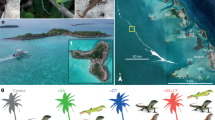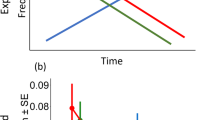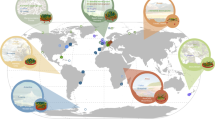Abstract
HISTORICAL ecology contains various examples of how predators introduced onto islands by man have apparently exterminated native prey species1–6. Conversely, a pioneering experiment7 showed an increase in number of species with predator presence. Subsequent experiments have shown both increases and decreases in prey diversity8–10. Here we investigate how predator introduction affects one aspect of prey diversity (number of species or species richness), and prey abundance. We ran a seven-year experiment on an entirely natural system of small islands, using the commonest local lizard as the predator and web spiders as prey. Lizard introduction caused rapid and devastating effects on spider diversity and abundance: within two years, islands onto which lizards had been introduced became almost identical to islands with natural lizard populations. The proportion of species becoming extinct was 12.6 times higher on lizard-introduction' islands than on islands without lizards. Locally common and rare species were both reduced by the introduction of lizards, but nearly all of the latter became permanently extinct.
This is a preview of subscription content, access via your institution
Access options
Subscribe to this journal
Receive 51 print issues and online access
$199.00 per year
only $3.90 per issue
Buy this article
- Purchase on Springer Link
- Instant access to full article PDF
Prices may be subject to local taxes which are calculated during checkout
Similar content being viewed by others
References
Diamond, J. & Case, T. J. in Community Ecology (eds Diamond, J. & Case, T. J.) 65–79 (Harper & Row, New York, 1986).
Mooney, H. A. & Drake, J. A. (eds) Ecology of Biological Invasions (Springer, New York, 1986).
Case, T. J., Bolger, D. T. & Richman, A. D. in Conservation Biology: The Theory and Practice of Nature Conservation, Preservation and Management (eds Fiedler, P. L & Jain, S. K.) 91–125 (Chapman & Hall, New York, 1992).
Pimm, S. L. The Balance of Nature? (Univ. Chicago Press, Chicago, 1991).
Holt, R. D. & Lawton, J. H. A. Rev. Ecot. Syst. 25, 495–520 (1994).
Simberloff, D. in Encyclopedia of Environmental Sciences Vol. 2 (ed. Nierenberg, W. A.) 323–336 (Academic, London, 1995).
Paine, R. T. Am. Nat. 100, 65–75 (1966).
Sih, A., Crowley, P., McPeek, M., Petranka, J. & Strohmeier, J. A. Rev. Ecol. Syst. 16, 269–311 (1985).
Fuentes, E. R. & Jaksić, F. M. Oikos 53, 139–143 (1988).
Hixon, M. A. in Contemporary Studies on Fish Feeding (eds Simenstad, C. A. & Cailliet, G. M.) 235–257 (Junk Publishers, Dordrecht, 1986).
Spiller, D. A. & Schoener, T. W. in Food Webs: Integration of Patterns and Dynamics (ed. Polls, G. & Winemiller, K.) 160–169 (Chapman & Hall, London, 1996).
Schoener, T. W. & Spiller, D. A. Science 236, 949–952 (1987).
Spiller, D. A. & Schoener, T. W. Ecol. Monogr. 58, 51–77 (1988).
Spiller, D. A. & Schoener, T. W. Oecologia 83, 150–161 (1990).
Spiller, D. A. & Schoener, T. W. Ecology 75, 182–196 (1994).
Schoener, T. W. & Spiller, D. A. Am. Nat. 139, 1176–1207 (1992).
Losos, J. B., Marks, J. C. & Schoener, T. W. Oecologia 95, 525–532 (1993).
Schoener, T. W., Spiller, D. A. & Morrison, L. W. Acta Oecologica 16, 103–121 (1995).
Schoener, T. W. & Spiller, D. A. Nature 330, 474–477 (1987).
Schoener, T. W. Acta Oecologica 12, 53–75 (1991).
Rice, W. R. Evolution 43, 223–225 (1989).
Roughgarden, J. & Feldman, M. Ecology 56, 489–492 (1975).
Schoener, T. W. Am. Scient 70, 586–595 (1982).
Holt, R. D. Oikos 50, 276–290 (1987).
Mittelbach, G. G. & Chesson, P. L. in Predation: Direct and Indirect Impacts on Aquatic Communities (eds Kerfoot, W. C. & Sih, A.) 315–322 (Univ. Press of New England, Hanover, 1987).
Schoener, T. W. & Schoener, A. J. Anim. Ecol. 49, 19–53 (1980).
Pimm, S. L. & Lawton, J. H. Nature 275, 542–544 (1978).
Schoener, T. W. Ecology 49, 704–726 (1968).
Polis, G. A., Myers, C. A. & Holt, R. D. A. Rev. Ecol. Syst. 20, 297–330 (1989).
Schoener, T. W. & Spiller, D. A. Science 267, 1811–1813 (1995).
Author information
Authors and Affiliations
Rights and permissions
About this article
Cite this article
Schoener, T., Spiller, D. Devastation of prey diversity by experimentally introduced predators in the field. Nature 381, 691–694 (1996). https://doi.org/10.1038/381691a0
Received:
Accepted:
Issue Date:
DOI: https://doi.org/10.1038/381691a0
This article is cited by
-
Ecological drivers switch from bottom–up to top–down during model microbial community successions
The ISME Journal (2021)
-
Predator-induced collapse of niche structure and species coexistence
Nature (2019)
-
Fish community succession and biomanipulation to control two common aquatic ecosystem stressors during a large-scale floodplain lake restoration
Hydrobiologia (2017)
-
Effects of reconstruction of a pre-European vertebrate assemblage on ground-dwelling arachnids in arid Australia
Oecologia (2015)
-
Effects of abandoned Eucalyptus plantations on lizard communities in the Brazilian Cerrado
Biodiversity and Conservation (2014)
Comments
By submitting a comment you agree to abide by our Terms and Community Guidelines. If you find something abusive or that does not comply with our terms or guidelines please flag it as inappropriate.



